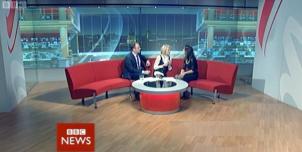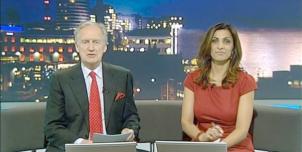Full Freeview on the Waltham (Leicestershire, England) transmitter
| Google Streetview | Google map | Bing map | Google Earth | 52.801,-0.801 or 52°48'4"N 0°48'5"W | LE14 4AJ |
The symbol shows the location of the Waltham (Leicestershire, England) transmitter which serves 770,000 homes. The bright green areas shown where the signal from this transmitter is strong, dark green areas are poorer signals. Those parts shown in yellow may have interference on the same frequency from other masts.
_______
Digital television services are broadcast on a multiplexes (or Mux) where many stations occupy a single broadcast frequency, as shown below.
64QAM 8K 3/4 27.1Mb/s DVB-T MPEG2
DTG-12 QSPK 8K 3/4 8.0Mb/s DVB-T MPEG2
H/V: aerial position (horizontal or vertical)
Which Freeview channels does the Waltham transmitter broadcast?
If you have any kind of Freeview fault, follow this Freeview reset procedure first.Digital television services are broadcast on a multiplexes (or Mux) where many stations occupy a single broadcast frequency, as shown below.
64QAM 8K 3/4 27.1Mb/s DVB-T MPEG2
DTG-12 QSPK 8K 3/4 8.0Mb/s DVB-T MPEG2
H/V: aerial position (horizontal or vertical)
Which BBC and ITV regional news can I watch from the Waltham transmitter?

BBC East Midlands Today 0.9m homes 3.4%
from Nottingham NG2 4UU, 28km northwest (306°)
to BBC East Midlands region - 17 masts.

ITV Central News 0.9m homes 3.4%
from Birmingham B1 2JT, 83km west-southwest (244°)
to ITV Central (East) region - 17 masts.
All of lunch, weekend and 80% evening news is shared with Central (West)
Are there any self-help relays?
| Braunstone | Transposer | 5 km SW Leicester city centre | 170 homes |
How will the Waltham (Leicestershire, England) transmission frequencies change over time?
| 1984-97 | 1997-98 | 1998-2011 | 2011-13 | 2013-18 | 2013-17 | 4 Mar 2020 | |||
| C/D E | E | E | W | W T | W T | W T | |||
| C26 | LNG | LNG | |||||||
| C29 | SDN | SDN | SDN | SDN | |||||
| C31 | com7 | com7 | |||||||
| C32 | BBCA | ||||||||
| C34 | D3+4 | ||||||||
| C35 | C5waves | C5waves | BBCB | ||||||
| C37 | com8 | com8 | |||||||
| C41 | _local | ||||||||
| C49tv_off | BBCA | BBCA | |||||||
| C54tv_off | C4waves | C4waves | C4waves | D3+4 | D3+4 | D3+4 | |||
| C55tv_off | com7tv_off | ||||||||
| C56tv_off | ArqA | ArqA | ArqA | COM8tv_off | |||||
| C57tv_off | ArqB | ArqB | ArqB | ||||||
| C58tv_off | BBC1waves | BBC1waves | BBC1waves | BBCB | BBCB | BBCB | |||
| C61 | ITVwaves | ITVwaves | ITVwaves | BBCA | |||||
| C64 | BBC2waves | BBC2waves | BBC2waves |
tv_off Being removed from Freeview (for 5G use) after November 2020 / June 2022 - more
Table shows multiplexes names see this article;
green background for transmission frequencies
Notes: + and - denote 166kHz offset; aerial group are shown as A B C/D E K W T
waves denotes analogue; digital switchover was 17 Aug 11 and 31 Aug 11.
How do the old analogue and currrent digital signal levels compare?
| Analogue 1-5 | 250kW | |
| BBCA, D3+4, BBCB | (-7dB) 50kW | |
| SDN, ARQA, ARQB | (-10dB) 25kW | |
| com8 | (-12.7dB) 13.4kW | |
| com7 | (-13.9dB) 10.2kW | |
| Mux 1* | (-14dB) 10kW | |
| Mux 2*, Mux A*, Mux B* | (-14.9dB) 8kW | |
| Mux C*, Mux D*, LNG | (-17dB) 5kW |
Local transmitter maps
Waltham Freeview Waltham DAB Waltham AM/FM Waltham TV region BBC East Midlands Central (East micro region)Which companies have run the Channel 3 services in the Waltham transmitter area
|
|
Thursday, 19 December 2013
J
john tebbs11:41 PM
Newark
John Tebbs Edingley. Myaerial is roof mounted and has a masthead amppifier. In fact I have two and both give the same problem. The changeover I referred to was the change in digital channels which gave a stroner signal with no pixellation for a while. Many people locally changed to Waltham from Belmont at that time but recently many have experienced weak or complete loss of signal. Is this due to 4g. I understand that a weak signal leaves me more susceptible to interference from traffic. I live close to a main road and the aerial points right down the road. I use a filter on each tele but that does not reduce the interference.
| link to this comment |
john's: mapJ's Freeview map terrainJ's terrain plot wavesJ's frequency data J's Freeview Detailed Coverage
Friday, 20 December 2013
J
jb3812:03 AM
Steve N : Further to that already said, I carried out another 10 minute check at 23.00hrs and can report that the situation remains unchanged, i.e: a rock steady signal from "all" of Watham's mux transmitters including Ch29 the one in question.
Of course I am receiving the signal from a different sector on the mast and that under certain circumstances can make a difference, although I feel that your problem is not connected with anything concerning the transmission of the signal and is caused by either a faulty connection somewhere on your aerial system, the point where the coax is terminated into the aerial being a favourite spot, or on the other hand possibly being caused by factors related to the changing weather conditions as muxes are not necessarily all received at the same levels to each other, and indeed in some areas are more frequently not!
Its really a case of making a local enquiry to find out if others are also experiencing a similar problem to yourself, although most aerials I see in your area are facing towards Sutton Coldfield and not Waltham, the former indicated as providing a superior signal.
| link to this comment |
MikeP
7:33 PM
7:33 PM
Michael
I am saying that analogue cannot and does not suffer from pixelation - that is a purely digital artifact. So Freeview, FreeSat and Sky can all potentially suffer from pixelation as they are digital transmissions. Before switch over, all terrestrial transmissions were in analogue format so could not have pixelation, but they did suffer from co-channel and adjacent channel interference when high pressure systems caused signals to travel further than normal- as it does also with digital transmissions as some have reported here. Sky have been digital for longer than terrestrial transmissions have.
| link to this comment |
Friday, 27 December 2013
M
Michael12:39 AM
MikeP: I agree that analogue does not suffer with pixelation. But as I'm sure you are aware, digital terrestrial transmissions in the UK have been ongoing since 15 November 1998 according to Wikipedia.
So I'm not sure why you say that before DSO all transmissions were in analogue only - when clearly they were in both analogue and digital!
| link to this comment |
M
Mike Davison10:27 AM
Wetherby
Mike P: You are technically correct that Sky have been providing digital TV on satellite longer than any terrestrial service but only by 6 weeks. Considering that Sky were part of the consortium set up in 1997 to get DTT going, you could say that their partners were left in the lurch when Sky pulled out in a possible commercial attempt to scupper DTT. I am not a fan of Sky and any subscription television. My philosophy is that if they don't want to make it easy to watch their programmes, it's their loss not mine. To get back to technical matters, pixellation - so what. That's a problem with MPEG2 which is greatly reduced on the MPEG4 HD channels which have far superior definition that analogue could never match for the bandwidth used. The only analogue system that came close was the old french 819 line interlaced system(monochrome only) which needed 14 MHz per channel.
| link to this comment |
Mike's: mapM's Freeview map terrainM's terrain plot wavesM's frequency data M's Freeview Detailed Coverage
R
Richard Borland1:40 PM
Has there been an issue in the southeast (hove) since the 23rd dec. I realise we have had some extreme weather conditions but we don't tend to suffer as much as we have. No itv and channel 4 and when there is it's very poor.
| link to this comment |
MikeP
8:15 PM
8:15 PM
Michael:
I stated that all *terrestrial* transmissions before switchover were analogue. Sky is not a terrestrial service and has been digital since 1998. There were NO digital terrestrial transmissions (other than brief test transmissions) before 2008. Wikipedia is again wrong or at best misleading. It is confusing the digital services from Sky with those from the terrestrial broadcasters and should not be relied upon.
After my 50 years in the industry before retiring I am well aware of what format the transmissions we using.
| link to this comment |
MikeP
8:17 PM
8:17 PM
Mike Davison:
Would you please enlighten us as to which terrestrial services were being transmitted digitally before 2008?
| link to this comment |
MikeP: As I recall, Channel 4 was *distributed* as 10Mbps motion-JPEG to the terrestrial broadcast points before the launch of DVB-T in 2008. But it was, of course, converted to "625 line" PAL for broadcast.
And PAL did have two digital components: Teletext and NICAM (sound).
| link to this comment |
Mike Davison: To be technically accurate, Sky was part of the British Digital Broadcasting bid for what became ONdigital.
It was the regulator that required them to remove their membership.
Sky were keen to have a "finger in both pies" at the time.
See Popular misconceptions 3: looking back at DG Greg Dyke | About UK Free TV | ukfree.tv - 11 years of independent, free digital TV advice
| link to this comment |
Select more comments
Your comment please!





